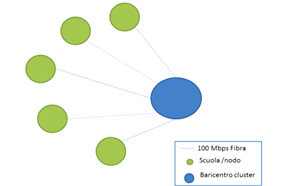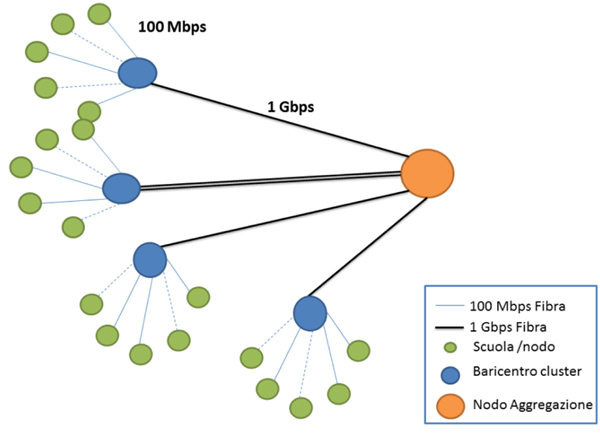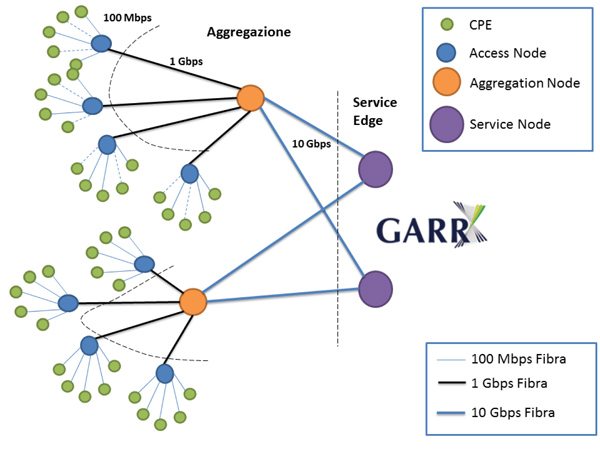Network Access Architecture
The project will provide schools with a bidirectional fiber link, with a guaranteed bandwidth capacity of at least 100 Mbps to the GARR-X Progress network infrastructure . To this end, an aggregation network will be implemented in order to interconnect schools while offering added-value services.
A high-quality, symmetric network enables the use of hardware and software technologies that require high bandwidth capacities not only in download but also in upload, such as audio- and video-streaming, e-learning and videoconferencing.
Available services include:
- Transparent IPv4/IPv6 routing;
- real-time videocommunication applications;

CLUSTER
cluster aggregation model.
BARICENTRO DEL CLUSTER
A higher aggregation level, with a fiber link capacity between 1 and multiples of 10 Gbps, could be needed to transport these single primary access nodes from this aggregation point to the GARR-PoP.
In order to interconnect in a sustainable way the largest possible number of schools with a capacity of at least 100Mbps, a one- or two-layer aggregation model was devised.
The number of levels used in a certain area depends on the number of schools that can be aggregated, as well as on their distance from a GARR site. The highest efficiency is obtained by globally minimizing the distance of all aggregation points (hubs) from a GARR PoP, while at the same time minimizing the sum of the distances between each school and its hub.
As a general rule, the clusters’ focal point is the best place where to locate a hub; however, in practice the clusters are selected on the basis of the shorter distance between such hypothetical point and:
- A GARR-X progress infrastructure PoP;
- A telco telehouse offering access fibers;
- A GARR user site suitable to host the link/a hub aggregating more school links;
- A school suitable to assume the function of cluster hub.
The preferred solution will be the one that ensures the most efficient solution at the lower cost. The cluster aggregation model can be replicated on several levels, depending on the number of links to be aggredated.

Up 20 links could be aggregated at the first level, through a primary fiber link with a bandwith capacity in the order of 1-2 Gbps interconnecting the cluster’s hub to the aggregation point.

This second layer, which aggregates a larger number of links, will require a higher level of dependability. Thus priority for second level aggregation hubs will be given to sites with redundant access to the GARR network, such as the GARR-X Progress IP/MPLS PoPs, or GARR user sites with backup links or that are ring-protected thanks to the interconnection with meshed infrastructures typical of MANs and RANs.
GARR will provide and manage the equipment to interconnect the schools, in addition to IPv4 and IPv6 public addressing space. The proposed access solution is technically scalable and allows for easy upgrades in the event of increased bandwidth requirements.
Fiber access
The network infrastructure and the equipment used both on the user’s end and at the aggregation hubs and PoPs allows to easily upgrade the link capacity, thus allowing for scalability in the next years.
Overview of fiber optic infrastructure in the schools
The network infrastructure is foreseen to interconnect about 260 school sites,. For each school included in the project a geographical proximity analysis was carried out to determine the best termination point.
The project in numbers
| School buildings | about 260 |
| Aggregated access bandwidth | about 26 Gbps |
| Km of access fibers | 900 |









